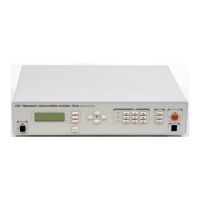Section 3 – Remote Mode
3.1 Programming Modes
The ESP is a command driven system. In general commands are a
series of two letter ASCII characters preceded by an axis number and
followed by parameters specific to the command. To communicate
with the ESP controller, a host terminal has to transfer ASCII character
commands according to the respective communication protocol (See
Section 3.2 for IEEE-488 or RS232 interfaces).
As briefly mentioned in Section 2, the ESP distinguishes between two
different programming modes:
COMMAND MODE
In this mode, the ESP controller provides a command input buffer
enabling the host terminal (e.g., PC) to download a series of
commands and then proceed to other tasks while the ESP controller
processes the commands.
As command characters arrive from the host terminal, they are placed
into the command buffer. When a carriage-return (ASCII 13 decimal)
terminator is received, the command is interpreted. If the command is
valid and its parameter is within the specified range, it will be
executed. If the command contains an error, it will not be executed and
a corresponding error message will be stored in the error buffer.
NOTE
The ESP power up state is command mode.
An example of a typical command sequence is shown below:
Example 1:
1PA + 30 move axis 1 to absolute position 30 units
1WS wait for axis 1 to stop
2PR-10 move axis 2 to relative position 10 units
Section 3 − Remote Mode 3-1

